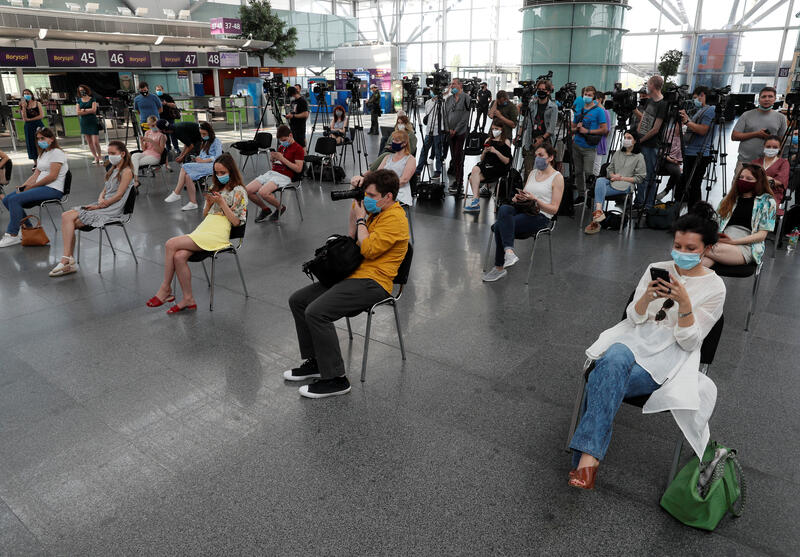Our podcast: how 2020 changed journalism

Journalists attend a news conference, Kiev, Ukraine June 13, 2020
The topic
2020 has been a year like no other. World-changing events including the COVID-19 pandemic, the movement for racial justice, a fractious US presidential election and the continuation of the Brexit process have had a huge impact on our societies. Journalism has not been exempt. Journalists have reported on a complex, never-ending story, sometimes risking their lives, often under threat. The year has accelerated changes in the news industry and has created a reckoning that was long overdue, bringing layoffs and losses and a few silver linings too.
In this final podcast of the year, members of our senior leadership team reflect on this momentous year for journalism and what we can perhaps look forward to next year.
The guests
Our host is Eduardo Suárez, Head of Communications
Our guests are:
- Rasmus Nielsen, Director
- Meera Selva, Director of the Journalist Fellowship Programme
- Federica Cherubini, Head of Leadership Development
- Richard Fletcher, Senior Research Fellow and Leader of our Research Team
The podcast
On Spotify | On Apple Podcasts | On Google Podcasts
Transcript
On the impact of COVID-19 on press freedom | On the struggle for press freedom in 2021 | On pushing for diversity in newsrooms | On COVID-19's impact on news consumption | On tracking the UK's attitudes to news about the pandemic | On journalism's role in boosting confidence in vaccines | On looking forward | Conclusion
On the impact of COVID-19 on press freedom ↑
Meera: I think those who wouldn’t attack journalists used every excuse they could to do it this year. So what we started with was concerns over misinformation that was spreading online over COVID-19. The term ‘infodemic’ that was coined by the WHO was used by authoritarian leaders to attack journalism. So there was legislation passed in Hungary very early on, for example, that made it kind of illegal to spread what would be classed as fake news or news that causes public panic. But it was, in fact, legislation that could be very used to attack critical reporting. And even when the laws weren’t used as such, they had a very chilling effect on journalism. Journalists became very scared of reporting.
On the struggle for press freedom in 2021 ↑
Meera: I think it’s getting harder and harder for journalists to access politicians directly, whether it’s in press conferences or through interviews. It can also be very hard for journalists to get onto the ground because of all the restrictions we’ve had. It’s become very easy to seal off certain areas, whether they’re hospital wards or certain regions, and say, “You’re not permitted to go in and report.” So I think this is a real issue for press freedom and the ability of journalists to go in.
The other thing I’m concerned about is the role of the contact test and tracing data and data protection generally, because I think there’s a lot of data being gathered under emergency legislation without the necessary protections. And I can easily see scenarios where this is used to both attack journalists and also to attack their sources.
On remote working and downsizing office space ↑
Federica: The pandemic showed that what, in some newsrooms, felt impossible before, was in fact doable, of course, which is working in distributed settings with teams in different location. And working from home, at least to a certain degree, is here to stay. 54% of the people we surveyed in our Changing Newsrooms 2020 survey said that they would like to go back to the office a bit less than before, for example. So I think we’ll see many hybrid newsrooms in the future with some people in the office, some people working from home, some of course, reporting on the ground. And this will, of course, come with challenges. Extensive planning will be required and some challenges of communication to make sure that we keep everyone aligned and on the same page. And without creating differences and disadvantaged group between those who are in the office and those who are working from home.
But it will bring, also, some advantages, some flexibility, that we have all experienced, to some degree, during this year. And of course, an advantage in the possibility of recruiting away from the centre of the cities in some metropolitan cities in many countries where many papers are based. And therefore, hopefully, increasing the chances of hiring more diverse too.
On pushing for diversity in newsrooms ↑
Federica: 2020 has also accelerated the reckoning on the lack of diversity in newsrooms. Again, respondents in our Changing Newsrooms 2020 survey indicated a focusing on increasing specifically ethnic diversity is going to be the priority for 42% of the respondents. We’ve also seen, in the survey, a feeling that progress has been made in diversity at a junior level in organisations, but there is still a lack of diversity at the top. So that will be an area where people should focus. I think this is, of course, important, at an internal level, but also because the coverage that this organisation put out reflects the views of those who select the content. And the homogeneity of views portrayed means that a large part of the audience might also not feel heard and represented in the coverage, which is, of course, a big challenge.
I think news executives should focus on actively changing the situation and start gathering data and tracking internal progress that has been made, and putting people and budgets behind diversity initiatives. Of course, I’m aware, in the present situation, it is financially challenging for many newsrooms. This is not easy. But it’s, of course, something that needs to change and needs to happen. And as I mentioned before, take advantage of the flexibility of working and hiring more diverse, could be a place to start.
On COVID-19's impact on news consumption ↑
Richard: I think that clearly the coronavirus will have an effect on the work that journalists do and also the kind of broader structure of how the media works in different countries. But I think, from the point of view of the audience, it’s slightly harder to see what the lasting changes from coronavirus might be, if there are any. As you mentioned, news use surged at the beginning of the crisis, but I think since then, it’s started to return to some levels that are similar to what we’ve seen in previous years.
And more broadly, it’s not clear whether this surge was primarily driven by a desire to seek information about the virus or whether it was really just about people having more time in lockdown. And obviously, this matters for the patterns of news use we’ll see in the future. When it comes to trust, trusting coronavirus news started off very high, but in the UK, as we measured it, we saw that it started to fall quite sharply over the summer. And I think this was a consequence of the crisis and also the coverage, coming to be seen by the public as more and more political. And I think that’s likely to continue as countries face up to the economic consequences of the pandemic and the difficult political decisions that will go along with that. And it’s not clear to me, at the moment, that coronavirus will be good for trust in news in the coming years.
On tracking the UK's attitudes to news about the pandemic ↑
Richard: I think probably one of the most important things that we found, and it was just the clear difference in how much more trusted scientists, doctors and health organisations are for information about coronavirus, if compared to, say, politicians, governments or even the news media. And I know, not only that, it’s just how stable that sort of high level of trust was over time, even as mistakes were made and they came under enormous pressure.
I think evidence is starting to build up now that trust in these sources of expertise is linked to people’s knowledge about coronavirus and their willingness to follow guidance and take preventive steps. So I think one thing journalism could do – and I think this is particularly important from the point of view of public health – is perhaps to focus less on politicians and pundits in their coverage, and more on sources that are highly trusted and can demonstrably help people understand coronavirus and navigate the crisis better.
On journalism's role in boosting confidence in vaccines ↑
Rasmus: I think we should recognise, it’s up to journalists and editors if they see it as their role to improve trust around vaccines. I think the first commitment of most journalists and editors is to seek truth and report it and then let the cards fall as they may. And in that sense, they may not necessarily seek to play a role in increasing trust. But I think it’s clear that one can pursue factual straight reporting, and still think about the implications for public understanding of the situation that we’re in. Richard highlighted one thing. In part, it’s about the sources that reporters turn to – politicians, various pundits with opinions, sometimes political editors and others – are not held in high esteem by the public. And often don’t have the domain expertise to really explain either the practicalities of a vaccine programme the way a nurse or a doctor might, or the science, the way that a medical researcher and scientist could do it.
So one thing that journalists really can think about is the choice of sources, at least for stories that are about the vaccine and the vaccine programme itself. More doctors, more nurses, more scientists, fewer politicians, fewer pundits, fewer people with opinions. I think another thing is to sort of recognise, if you will, that we are very social animals and we respond to a sense of how other people are navigating a crisis. And in that sense, this is also, I think, completely in-line with the ambition of seeking truth and reporting it. More emphasis on the fact that the vast majority of people in every country where we have survey data, have very high confidence in the vaccine, say that they intend to take it, rather than the much, much smaller minority of people who are hesitant, let alone hostile to the vaccine.
It’s important to coverage the reality of vaccine hesitancy and to cover the reality of small communities of antivaxxers and people who are actively hostile to the idea of vaccines. But the risk in some of that coverage is that it creates the impression that these communities are much, much larger than they actually are. And the risk is that that will influence how the majority think about this, because they might worry that, even though they are confident that the vaccine will work and that they want to take it, if they get the impression that lots of people think differently, that will undermine their trust in the vaccine. So that’s something for journalists to think about, is the sources that they rely on and also how they cover issues around vaccine hesitancy, without losing sight of the fact that the vast majority have confidence in the science, have confidence in the health system and intend to take the vaccine as soon as they can.
On looking forward ↑
Rasmus: It is, of course, important to recognise that the backdrop here is very dark. Topline revenues in the industry continue to decline. Print is in inexorable decline. Broadcast is being disrupted by streaming and other digital services. Google and Facebook are gobbling up a large share of the digital advertising market, so the situation is extremely challenging. And most organisations see declining revenue, and that decline has been accelerated by the impact of lockdowns and the recession that has followed from the pandemic. It’s a really tough situation and I don’t think there is any value in sugar-coating just how grim it is for lots of news organisations.
But we shouldn’t overlook the fact that there are also a growing minority of news organisations who are doing well. And I think it’s particularly important to recognise, this is not just a few extremely unusual outliers who can appeal to a global, elite, English language market. It’s great for the New York Times and for the Washington Post and the Wall Street Journal and the Financial Times and The Economist, that they’re doing well. But fundamentally, they are very, very different from almost every other news organisation in the world in terms of their business opportunities.
I think a much more important thing to note is that we see, I think, especially in Europe, but not only in Europe, a growing number of examples of news organisations that do really distinct and valuable journalism. That people engage with and are willing to either pay for or support through membership. And we see it in markets that are much, much smaller than the English language market, in ways that delivering, in some cases, even growth in as tough a year as this year of the plague. We see it with some legacy organisations who have very successfully reinvented themselves for the digital environment. Whether that’s Dagens Nyheter in Sweden, Le Monde in France, NRC in the Netherlands, Spiegel in Germany – organisations that all report growing digital subscriptions. And they have tough years ahead of them because they’re still weaning themselves off a declining print revenue stream, but they have, I think, in many cases, quite a bright future ahead of them.
We also see it with some really impressive digital-born organisations. Some of that is in Europe. elDiario.es in Spain, Zetland in Denmark, De Correspondent in Netherlands, Mediapart in France. Even more encouragingly, I would say, and even more importantly, in a way, is the fact that we also see some examples in less-privileged countries, than, you know, rich and democratic sort of stable democracies in northwest Europe. Examples like the Daily Maverick in South Africa, Malaysiakini in Malaysia, or other examples of organisations that are building really impressive and inspiring business models around distinct quality journalism. And I think the rest of us can learn a lot from those organisations.
It’s tough. There is no way to cover that up and we shouldn’t cover that up. We have to face it. But I will say that there is a lot to be learned from organisations, like the Daily Maverick, as their CEO, Styli, says, ‘are born into the fire’. And I do have to say, if new entrants in South Africa and Malaysia can make the business of digital news work, then odds are, those of us who live in more privileged countries have a shot at it as well. So I think we can learn a lot from these inspiring examples of really great journalism that also generates sustainable business.
On wishes for journalism in 2021 ↑
Meera: I wish that the conversations we’ve been having about diversity in newsrooms and how important it is to have new voices and also just diversity at all levels of the news agenda – both reporters, editors, audiences. I would like this to be a reality and a sustained reality, not something that we speak about once and then forget about.
Federica: I wish for newsroom leaders to realise that, alongside innovation in product and tech on new business models and content formats – which are all very important – but for their organisations to thrive, they also need to invest in their people, who are the ones that make all of those innovations possible. And for this to be reflected in their choices and their strategic priorities for the year ahead.
Richard: I think my main wish is for measured and responsible coverage of the vaccination effort, because it’s just going to be critically important for the coming year.
Rasmus: I’m tempted to give a big speech, but I’ll just say, I wish that we will look at the world [of journalism] as it is in light of what it could be, rather than in the light of a romanticised, sentimental and airbrushed reminiscence of what we think it was like in the past.







